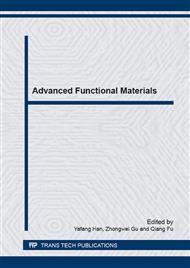p.129
p.135
p.141
p.149
p.154
p.159
p.166
p.171
p.176
Effects of Ba and Ti Codoping on Stoichiometric and Nonstoichiometric BiFeO3 Multiferroic Ceramics
Abstract:
Bi0.9Ba0.1Fe0.95O3 and Bi0.9Ba0.1FexTi0.05O3 (x=0.95, 0.925, 0.90) ceramics were prepared through conventional solid state reactions. X-ray diffraction analyses indicated that a high content of perovskite phase was obtained for all the four compositions. While the three (Ba,Ti)-codoped compositions all showed a higher resistivity than Bi0.9Ba0.1Fe0.95O3, and Bi0.9Ba0.1Fe0.925Ti0.05O3 had the best electrical and dielectric properties among the three (Ba,Ti)-codoped compositions, including the largest dielectric constant, the smallest dielectric loss at low frequency range, and the highest electrical resistivity. Magnetic hysteresis loop measurement revealed that the four compositions had similarly enhanced magnetic properties. It is concluded that much attention should be paid to fine composition adjustment when multiple elements are co-doped to BiFeO3 system.
Info:
Periodical:
Pages:
154-158
Citation:
Online since:
March 2015
Authors:
Keywords:
Price:
Сopyright:
© 2015 Trans Tech Publications Ltd. All Rights Reserved
Share:
Citation:


